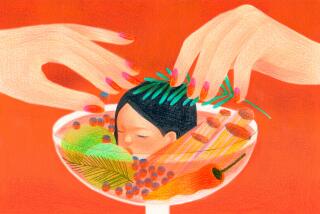Grape Growers Put Squeeze on Ad
- Share via
An advertising campaign by the Seagram’s Co., makers of distilled spirits and wine, is being labeled false and misleading by the California Assn. of Winegrape Growers.
In effect, the Seagram’s commercial states that four 1-ounce jiggers of distilled spirits, four 3-ounce glasses of wine and four 10-ounce glasses of beer contain the same amount of alcohol. The company plans to spend $10 million promoting the thought that consumption of any of the above results in the same effect on the body, according to a growers’ representative.
The winegrape group is particularly upset about being included with the likes of whiskey, vodka and gin and is urging the television networks not to run the ads. In a letter to NBC’s vice president of broadcast standards, the group maintains:
“Wine and beer are complex beverages containing many natural organic materials not found in distilled spirits, and they are highly buffered, which seems to delay the passage of alcohol from the stomach into the bloodstream (and) keep the maximum blood alcohol lower. . . . Any claim that these three products are equal in alcohol content without an explanation that they are different in their effects on how quickly and how much they cause intoxication . . . would be false and misleading. . . .”
The letter to NBC, written by Robert P. Hartzell, president of the growers association, states that this type of advertising could add credence to the campaign by “neo-Prohibitionists” to ban all advertisements for wine and beer in the broadcast media. The ads often criticized by those seeking a ban on beer and wine commercials are those that encourage alcohol consumption as opposed to enhancing brand recognition.
Pledging Sobriety--Consumption of alcoholic beverages is also at the heart of a campaign by the National Restaurant Assn. The group has launched Operation: Prom/Graduation, a program aimed at getting celebratory-minded students to tone down or eliminate their drinking during this festive season.
The plan involves getting students to sign a pledge promising not to drink and drive during the prom/graduation period and not to ride with an inebriated driver. In return for making a commitment to sobriety the students will receive 5% to 10% discount at participating local restaurants, florists, tuxedo rental stores and other related businesses.
Charting Teen Tastes--A survey of high school home economics students was conducted recently, and the teen-agers queried showed a detectable level of sophistication about food issues, according to Food Processing magazine.
For instance, 50% of those polled felt that artificial colors and flavors should be banned from foods. On the subject of sweeteners, 32.6% felt that sugar should not be added to processed foods, whereas 44.2% felt that it is safe as an added ingredient. The teens questioned felt that aspartame, trademarked as NutraSweet, is safe by a 41.4% to 25.8% margin, the magazine reported.
Saccharin did not fare as well. Fifty-five percent of those participating in the survey felt that saccharin should not be used in processed foods, whereas only 16.7% felt it was safe as an ingredient.
Picturing Thousands of Calories--There are times in the lives of chocolate lovers when increased consumption of the tasty candied morsels may prove deleterious to the waistline, complexion or blood-sugar level. Bringing solace to those who should not take another bite of dark chocolate marzipan is “Inside Chocolate: The Chocolate Lover’s Guide to Boxed Chocolates” by Hall and Ellen Greenberg (Harry N. Abrams).
This is a book that may be worth using in the human equivalent of Pavlov’s canine studies because of its real-life subject matter: Full-page pictures of many of the world’s famous chocolate candy box interiors. The picture is accompanied by an illustration of the box and the exact title of each candy.
Those fond of See’s candies can simply locate the company’s page and discover that those thin wafers on the bottom-right hand corner of the box are called milk-chips or milk chocolate molasses.
Other big names included in the book are Krums, Godiva, Moreau and Tobler.
Even the book itself looks much the way a box of chocolates would, with a shimmering gold cover. One chocolate devotee, who was disappointed that there were only pictures and words inside the work, said: “At least they could have included a scratch and sniff.”
More to Read
Eat your way across L.A.
Get our weekly Tasting Notes newsletter for reviews, news and more.
You may occasionally receive promotional content from the Los Angeles Times.










